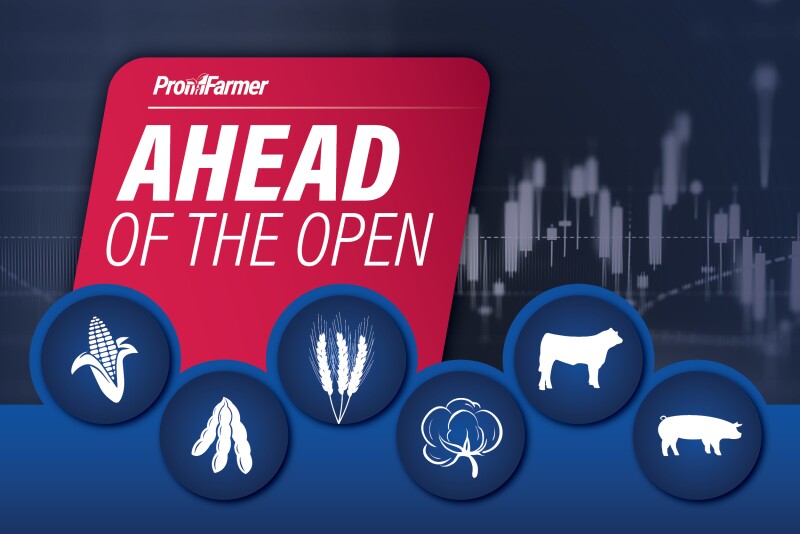GRAIN CALLS
Corn: 1 to 3 cents lower.
Soybeans: 3 to 6 cents lower.
Wheat: 1 to 3 cents lower.
GENERAL COMMENTS: While corn, soybeans and wheat tried at times to push higher overnight amid corrective buying, sustained buyer interest remained limited. Given a lack of supportive news, there’s risk of fresh selling, but heavy pressure doesn’t seem likely today and there could be some short-covering as traders start to prepare for Friday’s Crop Production and Supply & Demand Reports from USDA. The U.S. dollar index is firmer and front-month crude oil futures are weaker, though not enough for either to have a major influence on grain trade.
Weather remains favorable, if not ideal, for most major corn production areas as pollination starts. Seasonal temps and periodic rains are expected across the central U.S. through the Southeast over the 10-day to two-week period. That would allow the bulk of the corn crop to pollinate without weather stress. Barring a dramatic shift in weather, there’s little for traders to get concerned about, which will keep funds comfortably short corn. Weather is also favorable for soybean development, though the key period for that crop is August and early September.
Trade uncertainty also continues to hang over markets. President Donald Trump said on Tuesday the U.S. would “pretty soon” charge a 10% tariff on imports from BRICS countries, reiterating a threat he made on Sunday, without providing a specific date. That list of countries includes Brazil, Russia, India, China and South Africa, along with Egypt, Ethiopia, Indonesia, Iran and the United Arab Emirates.
Argentina’s first 30,000 MT shipment of soymeal to China, expected to set sail around midmonth, is seen as a test for potentially more exports. However, there are major headwinds before it could be turned into a meaningful trade. China is a small buyer of soymeal, instead opting to import large volumes of soybeans and crush them domestically.
Ukraine’s combined grain and oilseed crop production is expected to reach 83.1 MMT this year, Ukrainian grain traders union UGA said. That would allow the country to export a combined 50 MMT of grains and oilseeds in 2025-26, up from 46.7 MMT in the just completed 2024-25 marketing year.
CORN: December corn futures posted a contract low at $4.11 3/4 during overnight trade. Next support would come from the psychological $4.00 mark – a level which appears to be in bears’ sights as the contact continues to bleed lower. Resistance is layered from previous support at $4.16 3/4 to the 20-day moving average around $4.31.
SOYBEANS: November soybean futures fell below support at last month’s low of $10.13 1/4 overnight. Bears are now targeting the psychological $10.00 mark. Near-term resistance is layered in the $10.15 to $10.26 range.
WHEAT: September SRW futures continue to chop sideways, though bears have the modest upper hand. Near-term support is layered from the $5.45 area to last month’s low at $5.34 3/4. Monday’s gap from $5.53 3/4 to $5.56 3/4 stands as near-term resistance.
LIVESTOCK CALLS
CATTLE: Higher.
HOGS: Mixed.
CATTLE: Live cattle and feeders are expected to open higher after high-range closes and contract highs on Tuesday. August live cattle pushed to a contract high at $220.30 late in yesterday’s session, which is likely to trigger followthrough buying as traders continue to narrow the still-steep discount to the cash market. The combination of surging cattle futures and strong packer margins are building hopes cash cattle prices may be steady at worst this week following three straight weeks of decline. Despite the strong margins and light purchases the past two weeks, packers have been slow to establish bids this week, suggesting any significant cash trade won’t come until late in the week. Wholesale beef prices firmed $2.06 to $393.04 for Choice and 93 cents to $378.46 for Select on Tuesday.
HOGS: Lean hog futures are expected to open with a mixed tone. The cash hog index continues to weaken from its seasonal high, falling another $1.00 to $107.33 as of July 7. Summer-month futures finished Tuesday at mild discounts to today’s cash quote, which could limit seller interest. Pork cutout fell $1.48 to $112.01 on Tuesday as all cuts declined, led by a $5.27 drop in butts. Packer margins are solidly in the red, suggesting the pullback from seasonal highs in the cash and product markets will likely continue as slaughter supplies gradually start to build.

